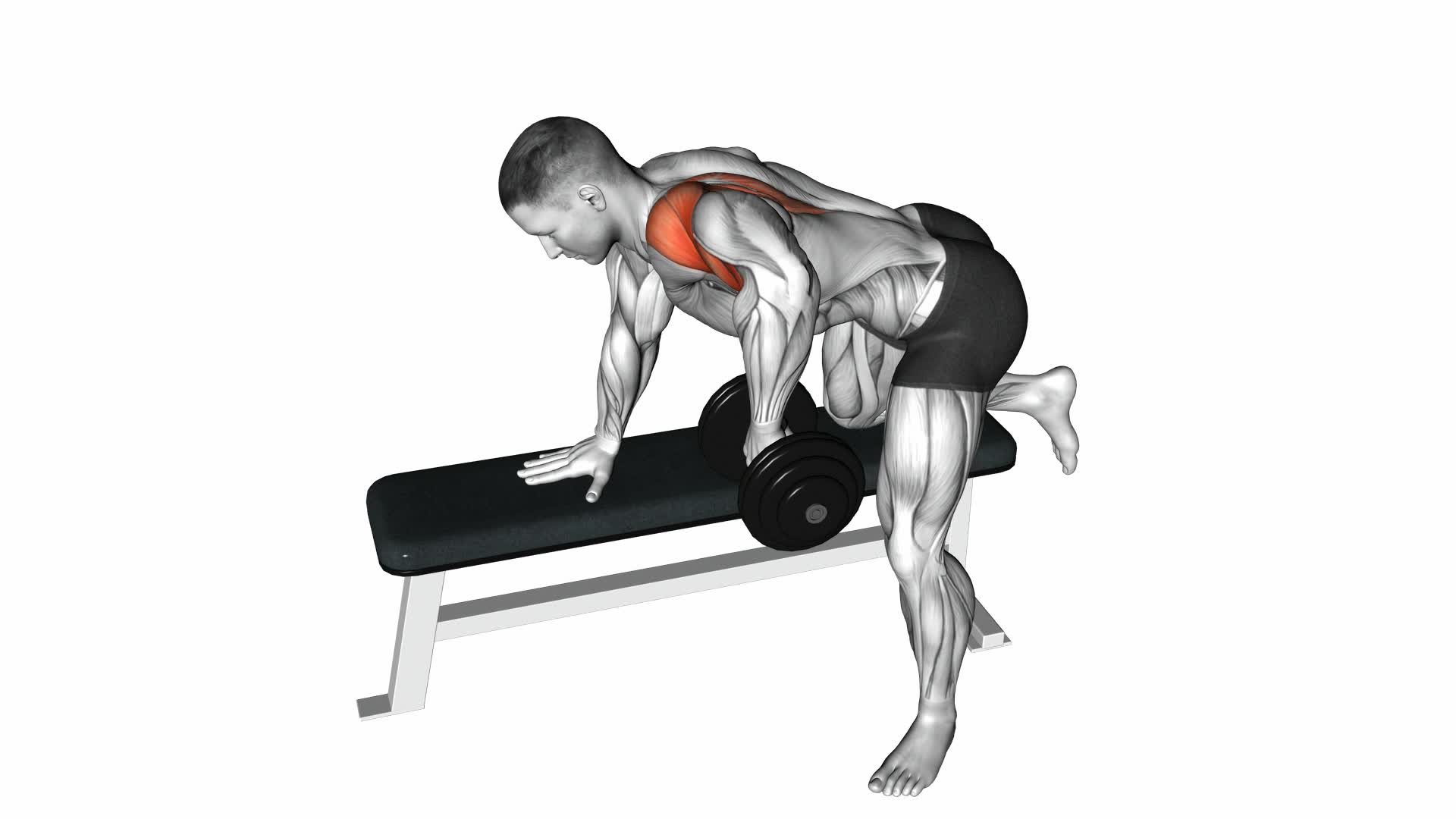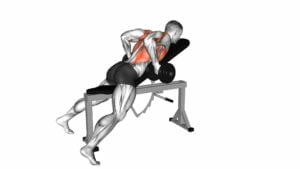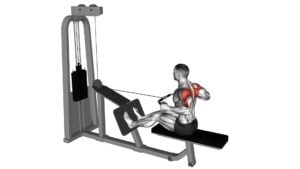Dumbbell Rear Delt Row – Video Exercise Guide & Tips

Looking to strengthen your rear delts? The dumbbell rear delt row is a great exercise to add to your routine.
Watch This Exercise Video
In this video exercise guide, we'll show you the proper form and technique for maximum results. You'll also learn about the equipment needed, common mistakes to avoid, and variations for progression.
Get ready to sculpt and tone your shoulders with this effective exercise. Let's dive in and get started!
Key Takeaways
- Improved shoulder strength and posture
- Targets posterior deltoid muscles
- Prevents imbalances and reduces risk of shoulder injuries
- Alleviates shoulder pain and discomfort
Benefits of the Dumbbell Rear Delt Row
You'll experience improved shoulder strength and posture with the dumbbell rear delt row. This exercise specifically targets the posterior deltoid muscles, which are responsible for shoulder stability and movement. By strengthening these muscles, you can prevent imbalances and reduce the risk of shoulder injuries.
One of the key benefits of the dumbbell rear delt row is improved shoulder health. As you perform the exercise, you engage the rear delts, which helps to stabilize the shoulder joint. This can alleviate shoulder pain and discomfort caused by muscle imbalances or weakness.
Additionally, the dumbbell rear delt row can also enhance your overall posture. As the exercise targets the upper back muscles, it helps to counteract the forward shoulder posture that's common in our modern sedentary lifestyles. By strengthening the muscles responsible for pulling the shoulders back, you can correct your posture and stand taller.
Incorporating the dumbbell rear delt row into your workout routine can provide numerous benefits for your shoulder health and posture. This exercise not only strengthens the posterior deltoids, but also improves overall shoulder stability and alignment. So, grab those dumbbells and start reaping the benefits of the dumbbell rear delt row.
Proper Form and Technique
To perform the dumbbell rear delt row with proper form and technique, position yourself in a bent-over position while holding dumbbells. Start by standing with your feet shoulder-width apart and knees slightly bent. Hinge forward at the hips, keeping your back straight and core engaged. Hold a dumbbell in each hand with your palms facing inwards towards your body.
When performing this exercise, it's important to avoid common errors that can compromise your form and prevent you from getting the most out of the exercise. One common error is rounding your back, which can put unnecessary strain on your spine. To avoid this, focus on keeping your back straight throughout the movement.
Another common error is using momentum to lift the dumbbells instead of relying on your muscles. To improve your form, focus on squeezing your shoulder blades together and using your back muscles to lift the dumbbells.
To improve your technique, start with lighter weights and gradually increase the load as you become more comfortable with the exercise. Additionally, make sure to maintain a controlled and slow tempo throughout the movement to fully engage your rear deltoids.
Now that you know how to perform the dumbbell rear delt row with proper form and technique, let's move on to the equipment needed for the exercise.
Equipment Needed for the Exercise
To perform the dumbbell rear delt row with proper form and technique, you'll need a pair of dumbbells. This exercise specifically targets the rear delts, which are the muscles located at the back of your shoulders. Dumbbells are an ideal choice for this exercise because they allow for a greater range of motion and provide stability during the movement.
Alternative equipment options for the dumbbell rear delt row include resistance bands and cable machines. Resistance bands can be used by looping them around a sturdy object and pulling back towards your body. Cable machines provide constant tension throughout the movement and can be adjusted to different resistance levels.
Modifications for different fitness levels can be made by adjusting the weight of the dumbbells used. Beginners can start with lighter weights and gradually increase as they build strength and confidence. If you don't have access to dumbbells, you can use household items like water bottles or cans as makeshift weights.
Remember to choose a weight that challenges you but still allows you to maintain proper form. It's important to keep your back straight, engage your core, and squeeze your shoulder blades together as you perform the exercise. By using the appropriate equipment and making modifications as needed, you can effectively strengthen and tone your rear deltoids.
Common Mistakes to Avoid
When performing the dumbbell rear delt row, it's important to avoid some common mistakes.
First, make sure your elbows aren't too high, as this can put unnecessary strain on your shoulders.
Additionally, be mindful of your grip placement to ensure proper form and activation of the targeted muscles.
Lastly, remember to engage your back muscles throughout the exercise to maximize its effectiveness.
Elbows Too High
Correct elbow positioning is crucial for proper form and effectiveness in the dumbbell rear delt row exercise. When performing this exercise, it's important to avoid the mistake of having your elbows too high. Keeping your elbows too high can limit the activation of your shoulder muscles and reduce the overall effectiveness of the exercise.
To ensure correct elbow positioning, start by standing with your feet shoulder-width apart and holding a dumbbell in each hand. Bend forward at the waist, keeping your back straight and your core engaged.
As you row the dumbbells up towards your chest, make sure to keep your elbows close to your sides and pointing slightly backward. Avoid lifting your elbows too high, as this can shift the focus away from your rear deltoids and onto other muscles.
Incorrect Grip Placement
Avoid making the mistake of gripping the dumbbells incorrectly during the dumbbell rear delt row exercise. Proper grip placement is crucial for maximizing the benefits of this exercise and preventing injury.
When gripping the dumbbells, ensure that your hands are firmly wrapped around the handles, with your palms facing each other. This grip position will help to engage your grip strength and maintain control throughout the movement.
Additionally, be mindful of your shoulder mobility. Avoid gripping the dumbbells too tightly, as this can restrict your range of motion and limit the effectiveness of the exercise. Instead, maintain a relaxed grip that allows for fluid movement and optimal engagement of the rear deltoid muscles.
Not Engaging Back Muscles
To effectively engage your back muscles during the dumbbell rear delt row exercise, focus on maintaining proper form and utilizing a full range of motion. One common mistake to avoid isn't engaging the back muscles enough, which can limit the effectiveness of the exercise.
To ensure proper muscle activation, start by retracting your shoulder blades and pulling them down towards your back pockets. This will help engage the muscles in your upper back, including the rear deltoids. Additionally, make sure to squeeze your shoulder blades together at the top of the movement to fully engage the back muscles.
If you find it difficult to engage your back muscles during the dumbbell rear delt row, there are alternative exercises you can try. These include bent-over rows, seated cable rows, and face pulls, all of which target the back muscles effectively.
Variations and Progressions
To increase the intensity of your dumbbell rear delt row exercise, try incorporating different variations and progressions. By adding variety to your routine, you can target your rear deltoids more effectively and challenge your muscles in new ways.
One variation you can try is the single-arm dumbbell row. This exercise allows you to focus on one side at a time, increasing the load on the working muscle.
Another option is the bent-over rear delt fly, which isolates the rear delts even more by removing the rowing motion. This exercise requires you to lean forward, keeping your back straight, and lift the dumbbells out to the side.
For advanced rear delt exercises, you can use resistance bands or cables instead of dumbbells. These tools provide constant tension throughout the movement, maximizing muscle activation.
Additionally, you can perform the exercise on an incline bench or stability ball to further challenge your stability and engage your core muscles.
Tips for Maximizing Results
To maximize your results, focus on engaging your rear deltoids throughout the entire dumbbell rear delt row exercise. By doing so, you'll be able to maximize the intensity of the exercise and activate your muscles effectively.
Here are some muscle activation techniques that can help you get the most out of your workout.
Firstly, make sure to maintain proper form throughout the exercise. Keep your back straight, chest up, and shoulders pulled back. This will ensure that your rear deltoids are the primary muscles being targeted.
Secondly, concentrate on squeezing your shoulder blades together at the top of the movement. This will help to engage the rear deltoids even more and increase the muscle activation.
Additionally, try using a lighter weight with higher repetitions to really focus on contracting and activating the rear deltoids. This will help to fatigue the muscles and promote muscle growth.
Lastly, don't forget to breathe properly during the exercise. Exhale as you pull the dumbbells up and inhale as you lower them down. This will help to maintain proper form and maximize the intensity of the exercise.
Frequently Asked Questions
How Many Sets and Reps Should I Do for the Dumbbell Rear Delt Row?
To determine the number of sets and reps for the dumbbell rear delt row, you need to consider your fitness goals, current fitness level, and the weight you're using.
Generally, it's recommended to perform 3-4 sets of 8-12 reps for muscle growth and strength development.
However, if you're a beginner or focusing on endurance, you can do more sets with lighter weights and higher reps.
Always listen to your body and adjust accordingly.
Can I Do the Dumbbell Rear Delt Row if I Have a Shoulder Injury?
If you have a shoulder injury, it's important to modify your exercises to avoid further discomfort or injury.
The dumbbell rear delt row may not be the best choice for you right now. However, there are alternative exercises that can help you work your rear deltoids without putting strain on your shoulder.
It's always best to consult with a healthcare professional or a certified trainer to determine the most suitable modifications for your specific injury.
Is It Necessary to Use Heavy Weights for This Exercise?
To answer your question, it's not necessary to use heavy weights for the dumbbell rear delt row exercise. While heavier weights can increase the challenge and promote muscle growth, lighter weights can still provide benefits.
Using lighter weights allows you to focus on proper form and technique, reducing the risk of injury. Additionally, you can vary the exercise by adjusting the angle of your body or using resistance bands instead of dumbbells.
Can I Substitute the Dumbbell Rear Delt Row With Other Exercises?
Yes, there are alternative exercises that you can substitute for the dumbbell rear delt row.
However, it's important to note the benefits of the dumbbell rear delt row. This exercise specifically targets and strengthens the rear deltoid muscles, which are important for proper shoulder function and posture. It's also a great exercise for improving upper body strength and stability.
How Often Should I Incorporate the Dumbbell Rear Delt Row Into My Workout Routine?
To properly perform the dumbbell rear delt row, you should start by selecting an appropriate weight and bending forward at the hips. Pull the dumbbells up towards your chest, squeezing your shoulder blades together.
This exercise targets the rear deltoid muscles, helping to improve upper back strength and posture. Incorporating the dumbbell rear delt row into your workout routine can be beneficial for developing a well-rounded upper body and preventing imbalances.
Conclusion
In conclusion, the dumbbell rear delt row is an effective exercise for targeting and strengthening the muscles in the rear delts. By maintaining proper form and technique, using the necessary equipment, and avoiding common mistakes, you can maximize the benefits of this exercise.
Additionally, incorporating variations and progressions can help further challenge your muscles and enhance your results. Remember to follow these tips to achieve the best possible outcome from your dumbbell rear delt row workouts.

Author
Years ago, the spark of my life’s passion ignited in my mind the moment I stepped into the local gym for the first time. The inaugural bead of perspiration, the initial endeavor, the very first surge of endorphins, and a sense of pride that washed over me post-workout marked the beginning of my deep-seated interest in strength sports, fitness, and sports nutrition. This very curiosity blossomed rapidly into a profound fascination, propelling me to earn a Master’s degree in Physical Education from the Academy of Physical Education in Krakow, followed by a Sports Manager diploma from the Jagiellonian University. My journey of growth led me to gain more specialized qualifications, such as being a certified personal trainer with a focus on sports dietetics, a lifeguard, and an instructor for wellness and corrective gymnastics. Theoretical knowledge paired seamlessly with practical experience, reinforcing my belief that the transformation of individuals under my guidance was also a reflection of my personal growth. This belief holds true even today. Each day, I strive to push the boundaries and explore new realms. These realms gently elevate me to greater heights. The unique combination of passion for my field and the continuous quest for growth fuels my drive to break new ground.







